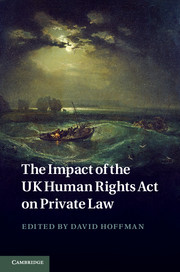Book contents
- Frontmatter
- Contents
- Contributors
- Foreword
- Preface
- Acknowledgements
- Table of cases
- Table of statutes
- Table of statutory instruments
- Table of European Union Legislation
- Abbreviations
- 1 Introduction
- 2 Mapping horizontal effect
- 3 Public authorities: what is a hybrid public authority under the HRA?
- 4 Statute law: interpretation and declarations of incompatibility
- 5 Precedent
- 6 Tort design and human rights thinking
- 7 Privacy: the development of breach of confidence – the clearest case of horizontal effect?
- 8 Nuisance
- 9 Defamation
- 10 Discrimination law
- 11 Damages: private law and the HRA – never the twain shall meet?
- 12 Property and housing
- 13 Commercial law
- 14 Restitution
- 15 Insolvency
- 16 Employment law
- 17 Civil procedure: Article 6 – a welcome boost to the development of English procedural law?
- 18 Conclusions
- Index
- References
4 - Statute law: interpretation and declarations of incompatibility
Published online by Cambridge University Press: 05 November 2011
- Frontmatter
- Contents
- Contributors
- Foreword
- Preface
- Acknowledgements
- Table of cases
- Table of statutes
- Table of statutory instruments
- Table of European Union Legislation
- Abbreviations
- 1 Introduction
- 2 Mapping horizontal effect
- 3 Public authorities: what is a hybrid public authority under the HRA?
- 4 Statute law: interpretation and declarations of incompatibility
- 5 Precedent
- 6 Tort design and human rights thinking
- 7 Privacy: the development of breach of confidence – the clearest case of horizontal effect?
- 8 Nuisance
- 9 Defamation
- 10 Discrimination law
- 11 Damages: private law and the HRA – never the twain shall meet?
- 12 Property and housing
- 13 Commercial law
- 14 Restitution
- 15 Insolvency
- 16 Employment law
- 17 Civil procedure: Article 6 – a welcome boost to the development of English procedural law?
- 18 Conclusions
- Index
- References
Summary
The impact of the HRA on statute law appears at first glance to be relatively straightforward compared with its impact on the common law. In relation to statutes the HRA provides specific mechanisms for giving effect to Convention rights, so courts have not had to fashion their own methods under section 6 as they have done in common law cases. There are two mechanisms provided: courts have a duty to render statutes compatible with the Convention by interpretation ‘so far as it is possible to do so’ (section 3), and where interpretation fails they have the power to issue a declaration of incompatibility (section 4). Although declarations of incompatibility do not affect the validity of legislation, Parliament has generally responded by repealing or amending the statute in question. The HRA thus provides a relatively clear grounding for the constitutional role of the courts when Convention rights are invoked in cases involving statutes, unlike common law cases in which the courts have had to resolve this role for themselves to a greater extent.
Important questions of judicial technique remain, however. The courts are fleshing out their constitutional role by developing new techniques of statutory interpretation in order to give effect to Convention rights, and by delineating the circumstances in which they will issue a declaration of incompatibility. These new techniques have brought far-reaching changes which are of interest to both public and private lawyers. Sir Jack Beatson has observed extracurially that section 3 ‘makes statutory provision more like common law doctrine’, due to the relative decline in importance of the statutory text and the increased importance of Convention case law in determining the interpretation that a court ultimately adopts. Beatson argues that this development may render statutes more ‘opaque’ to the ordinary litigant. These remarks raise important themes for this chapter, as they draw attention to the need for courts to strike a balance between the protection of Convention rights and the value of legal certainty when private legal relationships are conducted within a statutory framework. Parliament shares responsibility with the courts for maintaining this balance, as the legislature is expected to respond to declarations of incompatibility by enacting a new or revised statutory framework to provide for the Convention rights that have been affected; indeed, Parliament may also respond to section 3 interpretations by revising the statute. Dialogue of this kind between the courts and the legislature is an important aspect of the impact of the HRA on statute law. This chapter aims to provide an overview of the impact on statutes in private law cases. The chapter is in three parts: the first deals with questions of mapping and situates statute law in relation to other forms of private law affected by the HRA; the second considers the judicial approach to issuing declarations of incompatibility and the legislative response thereto; and the third examines the extent to which the courts have modified existing doctrines of statutory interpretation in order to give effect to Convention rights in cases between private parties.
- Type
- Chapter
- Information
- The Impact of the UK Human Rights Act on Private Law , pp. 66 - 90Publisher: Cambridge University PressPrint publication year: 2011
References
- 2
- Cited by



